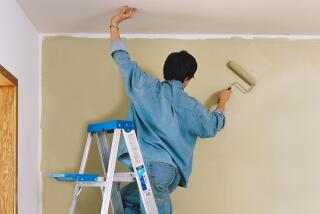DO-IT-YOURSELF : Preparation Will Ensure Painting Goes Smoothly
If you take time to prepare walls before painting them, they’ll not only look better, but the paint will last longer.
Assemble Your Materials
For easy cleanup, you’ll need plastic dropcloths, newspapers, large plastic trash bags and a roll of masking tape. For access, bring in ladders and boards for scaffolding. For repairs, have on hand spackling compound, plaster patch, wood filler, a heat gun or chemical paint remover, sander and sandpaper, tack cloth, vacuum cleaner and a spray can of primer.
Clear the Walls
Take down pictures and curtains. Remove picture hooks. Look for cracks, holes and peeling paint on walls and ceiling. Check the woodwork for loose paint, nicks, popped nails and separations at corners or at wall junctures. If there is wallpaper, you may want to strip it off.
Remove Furniture and Rugs
The more space you have to work in, the easier patching and painting will be. Move lightweight furniture to another room. Cluster heavy pieces in the center of the room. (Make sure you can reach the ceiling above the clustered pieces with a roller on a pole.) Cover them with a plastic dropcloth, and tie rope around the bottom to keep the cloth in place.
Dismantle Hardware
Remove knobs, latches and locks on doors and window frames. (To save removing a doorknob and all its hardware, loosen the escutcheon or plate behind the knob and tie a small plastic sandwich bag over it and the knob.) Take down curtain rods and brackets. Unscrew plates from electric switches and outlets. (To keep track of small pieces of hardware, tape them to the object with which they are used; for example, tape screws to the switch plate they normally hold in place.) If you have a ceiling fixture, disconnect it and take it down or loosen its plate and enclose it--plate and all--in a large plastic bag secured at the top with tape.
Masking
Mask windowpanes with tape or with liquid glass coating--up to 1/8-inch from the muntin, the strips separating panes of glass in a sash. It’s important to leave an unbroken film of paint adhering to the panes to protect wood muntins from condensation. Cover permanent installations such as built-ins and standing radiators with dropcloths. Tape plastic bags over wall sconces and thermostats.
Cover the entire floor (or carpeting) with plastic dropcloths, but ring the outer edges of the room with several layers of newspaper taped below the baseboards. Make a path of newspapers from the door into the center of the room. Newspaper absorbs wet paint and allows it to dry; plastic doesn’t. Paint on plastic stays wet, and if you step on it, you’re likely to track it into other rooms.
Make Repairs
Fill hairline cracks on walls and ceilings by smoothing on spackling compound.
Fill larger cracks with patching plaster. To make sure the patch adheres well, chisel out a triangular channel in the wall--narrower on the surface than inside--and fill it with the patching compound. When it’s dry, sand the surface smooth and prime.
Wash Down Surfaces
Use a heavy-duty detergent such as trisodium phosphate or a non-phosphate equivalent. Even fingerprints can keep paint from bonding properly. Clean any damp or mildewed area with a solution of one part household bleach to three parts water. Rinse and let the area dry completely before painting. Glossy surfaces may also need sanding, or an application of a commercial deglosser, for new paint to adhere properly.
